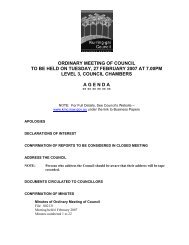Ku-ring-gai Heritage Conservation Areas North Inventory Sheet
Ku-ring-gai Heritage Conservation Areas North Inventory Sheet
Ku-ring-gai Heritage Conservation Areas North Inventory Sheet
Create successful ePaper yourself
Turn your PDF publications into a flip-book with our unique Google optimized e-Paper software.
<strong>Ku</strong>-<strong>ring</strong>-<strong>gai</strong><br />
<strong>Heritage</strong> <strong>Conservation</strong> <strong>Areas</strong> <strong>North</strong> <strong>Inventory</strong> <strong>Sheet</strong><br />
Item No<br />
Item Name<br />
Item Type<br />
Group Collection<br />
Category<br />
Key Historical<br />
Periods<br />
Primary Address<br />
Local Govt. area<br />
HCA 27 28 28a<br />
WAHROONGA HERITAGE CONSERVATION AREA<br />
<strong>Heritage</strong> <strong>Conservation</strong> Area<br />
Urban Area<br />
Townscape<br />
1890-1910s; Inter-war 1920s-1940s.<br />
Refer to map<br />
<strong>Ku</strong>-<strong>ring</strong>-<strong>gai</strong><br />
Boundaries<br />
Refer to map<br />
National Historic Themes<br />
State Historic Theme 1<br />
State Historic Theme 2<br />
State Historic Theme 3<br />
State Historic Theme 4<br />
Building settlements towns and cities<br />
Towns, suburbs and villages<br />
Persons<br />
Domestic Life<br />
Social Institutions<br />
Summary<br />
Statement of<br />
Significance<br />
Wahroonga <strong>Heritage</strong> <strong>Conservation</strong> Area is of heritage significance for its distinctive residential<br />
streetscapes which evidence the transformation of early subdivisions of the 1890s into the later<br />
rectilinear grid lot street and lot pattern of later subdivisions including the Wahroonga Heights<br />
Estate. The area contains a significant collection of grand residences from the Federation and<br />
Inter-war periods, built following the opening of the <strong>North</strong> Shore railway line in 1890, many of these<br />
the residences of prominent families of this period, and often designed by prominent architects, for<br />
example the 1894 Ewan House (formerly Innisfail) designed by architect Herbert Wardell for John<br />
Thomas Toohey, and eleven houses designed by the architect Howard Joseland. The western end<br />
of Burns Road and western side of Coonanbarra Road are representative streetscapes of intact<br />
more modest Federation period houses.<br />
The through-block pathways and formal avenues of street trees within the area (in Burns Road,<br />
Water Street and Coonanbarra Road) along with the formal landscaping of Wahroonga Park, and<br />
its distinctive John Sulman-designed shops in Coonanbarra Road facing the Park, are a tribute to<br />
the work of the Wahroonga Progress Association in the early 20th century (which included Sulman<br />
as a member), and have resulted in a high-quality and distinctive residential landscape.<br />
This area was one of <strong>Ku</strong>-<strong>ring</strong>-<strong>gai</strong>’s richest timber-getting areas, characterised by vast stands of<br />
cedar, mahogany, turpentine, ironbark and blue gum. Timber contractor Thomas Hyndes leased<br />
2000 acres (800ha) to the east of Lane Cove Road (now the Pacific Highway) by 1822. In 1840, the<br />
land was re-leased to John Terry Hughes, a prominent merchant and brewer, to whom a deed of<br />
grant was made out in 1842. The grant was measured from the Lane Cove Road, with the western<br />
border of the estate extending along the line of what became Woonona Avenue to Junction Road,<br />
thence further west into Hornsby Shire, the northern border being the present Boundary Road, and<br />
KU-RING-GAI HERITAGE CONSERVATION AREAS NORTH INVENTORY

















